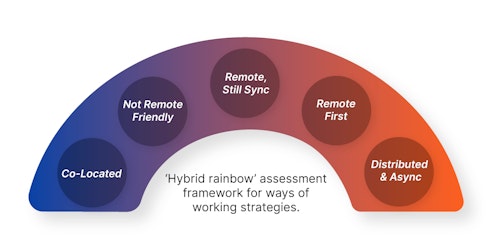The ‘hybrid rainbow’: how to orient your company strategy for action
Social and cultural barriers to hybrid collaboration can be more tricky to navigate than technical ones, which is why companies should go through a process of orientation to find the best route forward
Improving hybrid collaboration so that all meeting participants share a high-quality experience, irrespective of whether they are joining in-person or remotely, has become one of the defining challenges of the new world of work.
To explore this challenge in the round, Canadian workplace technology designer and integrator ET Group has teamed up with WORKTECH Academy on an article series that seeks to shake up current thinking on hybrid collaboration and test preconceptions around the issue.
In the first article in the series, a core hypothesis was presented, derived from ET Group’s digital communication projects with clients. This argued that neither investment in new technology nor redesign of meeting space would be sufficient on their own to move the dial.
Instead, the issue of meeting equality was linked – in the words of ET Group Senior Consultant Stephan Berchtold – to ‘what goes on beneath the surface of the company’. While the tech and spatial aspects of hybrid collaboration undeniably matter, the social interactions inside firms and the beliefs that underpin the structure of an organisation – termed organisational paradigms – tend to play a more critical and often unrecognised role. This thinking was captured in a presentation of ET Group’s ‘4 Pillars Model’, which has four main pillars: technology; place/space; social interaction; and organisational paradigms.
Below the waterline
Then, in our second article, we sought to validate our hypothesis in an online workshop with a group of 30 international companies drawn from WORKTECH Academy’s membership network. This confirmed that three out of four barriers to hybrid collaboration identified by workplace professionals are ‘below the waterline’, meaning that most of the barriers arise from aspects that belong to either social interaction or organisational paradigms. Yet, in many companies most of the attention goes to the more visible and tangible aspects of technology and space.
It is a situation that should give company decision-makers pause for thought, especially given current tension around bringing people back to the office or going fully remote. Where should business leaders aim their resources? Tech investment or a plan to shed office space? A focus on social interaction or a more holistic approach which embraces all four pillars? A key recommendation is to get more orientation first – and this is what this third article is all about.
Do not get us wrong, we are not arguing for an excessive analysis that leads to paralysis and never leads to action. Our observations show that very often organisations seem to be looking for solutions without really understanding what their specific situation calls for. They orient themselves around what other companies do, or at what is hyped as the latest and greatest idea on the market. Both approaches run the risk of creating a sub-optimal solution that lacks the needed fit to the specific situation of your organisation.
Getting oriented
So how can companies effectively orient themselves to get on the road to creating positive change? Here are some elements that decision makers should address:
- Understand your organisation’s barriers to hybrid collaboration: using the ‘4 Pillars Model’ is a helpful way to map the findings.
- Relate these barriers to a strategy around ways of working: do you have a shared understanding of the different options and their benefits and downsides?
- Uncover the interdependencies between barriers (mapped along the four pillars) with regards to your strategy around ways of working.
The framework below offers a way of understanding the different options that are available for companies looking into how they work and which strategy would be best for their organisation. It spans from full co-location to a remote but still synchronous way of working over to a fully distributed and asynchronous approach. ET Group senior consultant Stephan Berchtold simply calls this framework the ‘hybrid rainbow’. Accompanied by a set of questions, this tool can be used to help companies reflect on where they are on their workplace strategy journey.

‘Hybrid rainbow’ assessment framework for ways of working strategies, image courtesy of ET Group.
Key questions to ask
Looking at this diagram, ask yourself these questions:
- Consider your current situation. Which of the states introduced above describes best where you are now? There might be multiple states which apply to different teams in your organisation.
- Now look back one year and then two. Where were you a year ago and where were you two years ago?
- What changes have you witnessed? What is the reasoning behind these shifts? And what are some of the challenges that have resulted from these changes?
- Now look forward: where do you want to be in one year’s time? And for the bold amongst you, how about two years from now?
- Is this strategy a shared vision? Are decision makers in your organisation all aligned on the fact that this is your route forward?
The value of this assessment tool is found not only in helping organisations get a better understanding of where they are now and where they might be headed, but also in better understanding the potential tensions that could arise from a chosen approach. Companies can use this tool to align themselves better with their desired outcome and clear a way forward for collaboration.
Remember that many organisations do not sit in just one of the states, but in two, sometimes even three. This brings the challenge of finding the appropriate operational system as they have to cover a broad range.
After the orientation
Once companies have familiarised themselves with the ‘4 Pillar Model’ and oriented themselves on the ‘hybrid rainbow’ spectrum, they are now in a position to start making decisions about how they can best support their employees.
This will look very different for different companies. For example, a company in the state of ‘remote first’ which is heading towards a ‘distributed and asynchronous’ model might find that its strategy around space and facilities will look very different when compared to a company aiming to be fully ‘co-located’ in the office. While one will need (almost) no office, the other will need to invest heavily in space. With regards to investment into the technology, the set-up of meeting rooms also looks very different.
What about taking action to improve social interaction and organisational paradigms?
Consider an organisation working towards a distributed and asynchronous model of working. The impacts of this approach on social interaction are huge. This company might ask itself: how does informal communication happen within this model? How can we integrate and socialise new team members? How can formal and informal, over-the-shoulder learning happen?
When it comes to organisational paradigms, we need to address long-held beliefs and assumptions on how companies work. We might ask: how does the organisation tackle the issue of measuring productivity? What are some of the core rules and procedures that are built on the underlying assumptions and thus shape behaviour in our organisation?
‘Taking the time to orient yourself as an organisation can help facilitate decision-making…’
If the four pillars represent where the allocation of resources and money could go towards improving the hybrid collaboration experience, one thing should be clear: while going fully remote might reduce the costs of running an office space, it increases the level of resources needed to facilitate social interaction. Considering the factors involved in creating an effective hybrid working experience and taking the time to orient yourself as an organisation can help facilitate decision-making and create real impact on the experience of employees.
In the final article on our series, we will conclude by looking at implementation, with a special focus on delivering technology solutions. Once you have identified the barriers to effective hybrid collaboration and oriented yourself in the field, you can take steps towards implementing effective strategies and identifying the technologies that will support your organisational needs.








